***********************
August, 2006 (revised)I'd like to devote today's blog to walls. Walls are everywhere, but I seldom think about them. Maybe last year's torrential rains here in El Paso with the floods that ensued made me more aware of walls. That's because some of the deluge that inundated many folk's properties resulted when walls failed. In time, all walls will fail.
But let's start with one of my favorite walls. This one is one of many great walls in Taos, New Mexico that are made of adobe. It's simple, yet elegant. I took this picture a couple of years ago when I thought it was in danger of being torn down. But thankfully it wasn't. It was just repaired and remains intact. I like it.
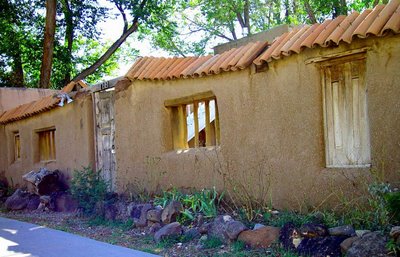 The job of this particular wall is to delineate private property from public property. As you walk along outside, it tells you, "Stay the hell out!" yet allows you to peek inside. That's nice.
The job of this particular wall is to delineate private property from public property. As you walk along outside, it tells you, "Stay the hell out!" yet allows you to peek inside. That's nice.Speaking of peeking through walls, there's new dressing room walls springing up at one of the stores of the English boutiques chain by Ann Summers. They sell lingerie among other items. This newly updated store will intentionally have walls with holes in them.
 According to an "Evening News" article, "cubicles in the new-look store will have small spy hole windows at eye-level. The idea is that women can throw open the peep hole, allowing their partners a peek at what they have to look forward to, without having to step out in front of other shoppers."
According to an "Evening News" article, "cubicles in the new-look store will have small spy hole windows at eye-level. The idea is that women can throw open the peep hole, allowing their partners a peek at what they have to look forward to, without having to step out in front of other shoppers."That's a nicely conceived wall. If they succeed in attracting more men into their stores as hoped, you can probably expect walls with holes to begin popping up eventually in American stores like Victoria's Secret.
There are walls designed to keep you out for your own protection. They keep you from getting too close to dangerous animals or falling into deep, sometimes sharp or hard places and killing yourself. As unbelievable as it may seem, there exist some people who still insist on feeding the bears by hand through such walls or leaning in just a little closer over them for a better shot of the canyon.
Walls can be made from many different things. Like the adobe, metal and sheet rock ones above, or the rock walls here in El Paso that proved no match for the torrents of water unleashed from the sky last year.
Placing our faith in rock walls proved to be bad in some areas. We thought they were strong, but were proved no match for poor drainage in sudden downpours. Here's a picture of a man surveying the rising waters in my neighborhood during those storms. Note the rock wall across the street from him. Just up the street one such wall that had been keeping uninvited waters from two homes collapsed leaving the rushing waters to shortcut through those homes which got extremely messed up.
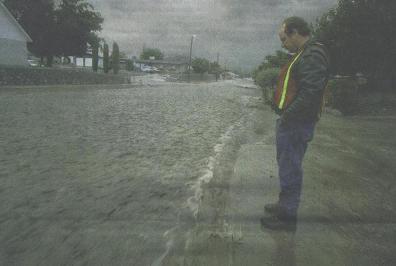 Here's an example of a wall made of much, much weaker and cheaper material which has proven to be far, far tougher than rock walls. They'll remain that way so long as people have faith that yellow plastic ribbon with the word "Police" inscribed somewhere on it is very tough material. Thus far they have been.
Here's an example of a wall made of much, much weaker and cheaper material which has proven to be far, far tougher than rock walls. They'll remain that way so long as people have faith that yellow plastic ribbon with the word "Police" inscribed somewhere on it is very tough material. Thus far they have been. Another material often used in walls is people. These can be very strong also and usually prevail in protecting things like democrats and republicans while holding conventions behind walled gathering centers. On an even larger scale, human walls can be used to save the nation from undocumented immigrant hordes coming through Mexico across our southern border. These have been far less successful. Maybe that's because immigrants are more passionate for their needs and less caring for their safety should they get caught in pursuit of those needs than their more passive and comfortable counterpart Americans.
Another material often used in walls is people. These can be very strong also and usually prevail in protecting things like democrats and republicans while holding conventions behind walled gathering centers. On an even larger scale, human walls can be used to save the nation from undocumented immigrant hordes coming through Mexico across our southern border. These have been far less successful. Maybe that's because immigrants are more passionate for their needs and less caring for their safety should they get caught in pursuit of those needs than their more passive and comfortable counterpart Americans.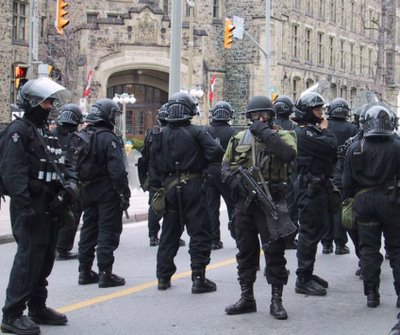 Oh sure, there were a few times when the human walls came close to failing here in the U.S. One such harrowing moment that immediately comes to mind is the 1968 democratic national convention in Chicago. There, unruly mobs gave police all they could handle. In 2004, a couple hundred thousand demonstrators outside the republican national convention, while unnerving in number, were basically peaceful, thus allowing those inside the convention to continue their agenda of ignoring popular demands.
Oh sure, there were a few times when the human walls came close to failing here in the U.S. One such harrowing moment that immediately comes to mind is the 1968 democratic national convention in Chicago. There, unruly mobs gave police all they could handle. In 2004, a couple hundred thousand demonstrators outside the republican national convention, while unnerving in number, were basically peaceful, thus allowing those inside the convention to continue their agenda of ignoring popular demands.While conventional walls of steel and concrete are strong, they are rigid and inflexible. Human walls are more fluid and unlike their non-human counterparts, can shoot guns. And when necessary, they can even "fall back" rather than be over-run.
However, it may help to remember in time all walls fail. It's just a question of when.
The biggest wall failure in recent history was the Berlin Wall which collapsed in 1989.
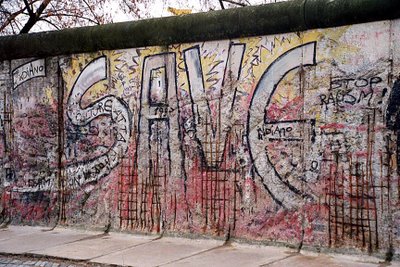 While it was originally designed and erected to keep people in, it also made a nice canvass for budding artists in need of self expression.
While it was originally designed and erected to keep people in, it also made a nice canvass for budding artists in need of self expression.Most walls are built to keep people out. The most spectacular example of that, of course, would be the Great Wall of China. Built in the Third Century, B.C., it stretched across 1,500 miles of China's northern border to discourage invaders from entering. But it failed in that purpose.
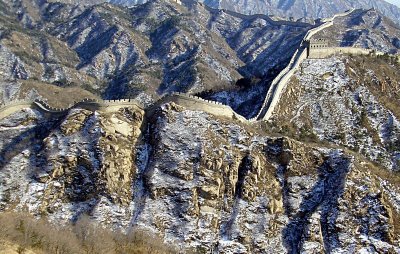 Today, however, the wall succeeds when used to draw people in--as a big ol' tourist attraction. It also continues in another unintended purpose, that of a source for construction workers to raid for building materials for other smaller walls and use in roadway paving.
Today, however, the wall succeeds when used to draw people in--as a big ol' tourist attraction. It also continues in another unintended purpose, that of a source for construction workers to raid for building materials for other smaller walls and use in roadway paving.Here's a couple examples of walls on far smaller scales. These that follow are similar to the Berlin Wall, i.e., designed to keep people in, not keep them out.
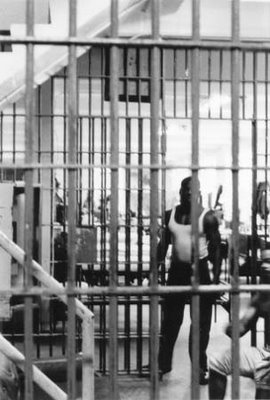 Here's a common, everyday prison. Prisons continue to propagate across the American landscape likes hordes of rabbits. As they expand in number, so does the percentage of Americans who have taken up residence behind their walls.
Here's a common, everyday prison. Prisons continue to propagate across the American landscape likes hordes of rabbits. As they expand in number, so does the percentage of Americans who have taken up residence behind their walls.While our current government often hides behind White House, Pentagon and congressional walls and halls to keep people away, more and more of the public is hoping to one day see these same government servants behind prison walls. To keep them away from us!
On an even smaller scale, there's the following little walls:
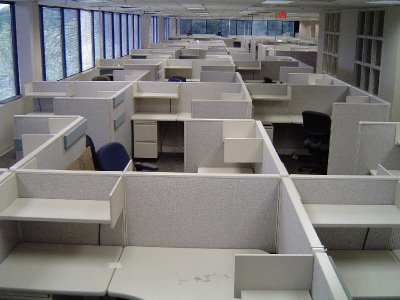 Scattered throughout America in corporate offices that have yet to move worker's jobs offshore are the walls of the fabled cubicles. (Sadly, this photo is from an office that has gone to India.)
Scattered throughout America in corporate offices that have yet to move worker's jobs offshore are the walls of the fabled cubicles. (Sadly, this photo is from an office that has gone to India.)I was fortunate to escape my job in corporate America before cubicles invaded our office. So I'm not sure what their exact purpose is. I really have no idea. Unless it's to dehumanize the workers behind them.
In my brief look at walls, these are probably the most touching ones. They are the walls erected to honor those who are no longer with us. Some represent policies of folly that took loved ones from us because of our national hubris.
 Other, less permanent walls, spring up immediately after a tragedy. Often made of flowers, notes to and photos of lost loved ones. The wall born of grief after 9/11 being the prime example.
Other, less permanent walls, spring up immediately after a tragedy. Often made of flowers, notes to and photos of lost loved ones. The wall born of grief after 9/11 being the prime example.
But I want to make a brief mention of probably the strongest walls of all -- the walls of dogma. I don't have any pictures of them. That's because, ironically, they are often the most invisible. Not so much because they can't be seen, but because those living behind them are often very blind.
Established dogmas exist as unassailable beliefs. They are walls erected specifically for defense against anyone skeptical enough to question or doubt the belief systems (BS) they protect. I recently heard Naomi Klein refer to such walls as "intellectual police lines."
Perhaps the heartiest (and most significant) of these dogmatic walls are maintained by religions and their churches. I'll not focus on those here because of the heated passions they can provoke. If your passions are aroused by the mere mention of these institutions and my refusal to devote time to them, whether believer or cynic, you illustrate -- and should appreciate -- my point.
Religion dogma is closely followed by governments and their political party subsets, increasingly, multi-national businesses and, not least of all, educational institutions and the academic experts who populate their hallways.
Governments give us pretty flags of colorful cloth to swear our allegiance to. Symbolizing our particular BS, if challenged to the extreme, one is obligated to kill or die for in its defense.
Business provides us logos to wear on clothing or sport on the ass ends of our vehicles to proclaim our allegiances to. Sometimes, as an arm of their government, they help write the national BS. Taken to the extreme like here in the U.S., business determines our BS by promoting fear and our reaction to it--wars -- but, hey, it's good for business.
Political parties give us symbols of elephants and asses and formidably exclude serious challenges from third parties and extremist views of members within their own. Mainstream media protects the BS of all of these.
And finally, educational institutions write our histories for us. Histories constructed under the prevailing paradigms of the day which in time congeal and harden into BS's of unassailable dogma such institutions purport to exist to refute.
While there are all kinds of walls, these are a few that come to my mind. From the most obvious to the most subtle and hardest to see. While serving many different purposes, in time they all will perish. Perhaps we should give thanks.

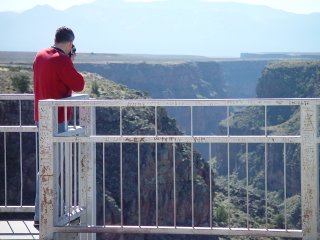

9 comments:
oh dada.....this is wonderful...poignant...sad...and funny....wise ....and real.....sigh...
Have a good Veteran's Day...
thank you for having served this country...
WOW!!!! You have covered just about every aspect of walls imaginable. Perhaps one of your best blog articles. The use of walls to keep us in or out, protected, or giving us a false sense of security- be it from water or those perceived as enemies.
The dogma element- walls in our minds, begged to be included. Least stucture of walls, but the hardest to overcome.
This is a fascinating concept. You don't have the brick wall I keep running into, but I've taken careful note.
Thank you for these wonderful walls! You REALLY tied them all together pefectly.
Do we have to wait for them to perish? We could climb over, tunnel under, or knock 'em down. There isn't a physical wall made that can survive a concerted assault. But those mental walls ... the dogma BS ... now that's much tougher ... how to dynamite through those "unassailable beliefs". A person who never questions can live such a nice comfortable life ... kind of like farm animals who think their routine will last forever, never wondering where all their buddies have disappeared to. Sometimes I do envy them.
I was thinking about the Great Wall of China today myself ... recalling my dad walking on it as a young sailor in WWII. And Cartledge has been posting about China, too, so there's more synchronicity there ...
I hope everyone has/had a nice Veteran's Day weekend. And in Australia, too, which I'm pretty sure has veterans, hence, probably celebrates 'em at some time during the year. (aha, Remembrance Day?, I just looked it up.)
Thank you all for the kind words. And TY, enigma, for the "Wall" mention on WS.
Good observation, Rutledge--about the brick wall omission. Actually, maybe I didn't mention it so as not to remind any readers here of the brick walls I'm pretty sure all have been slamming into more and more frequently these past 6-7 years. (Some days, I go out and intentionally slam my head against mine...it helps ease the pain.)
deke...your analogy of the bucolic life of the farm animals made me chuckle as they wonder where all their buddies keep disappearing to.
Sadly, that's beginning to slowly happen now to humans, too, isn't it?
Dada, Remembrance Day, we share tat with Canada, Britain et al, was last Sunday - 11/11 with a silence at 11 am.
The big Australian one is Anzac Day, 25/4. But our vets certainly aren't forgotten.
There is a strong feeling here of not celebrating war and conflict, but of remembering the people involved.
I guess it's something to do with the larrikan nature of Australians.
Ah, thanks for this, cartledge. ANZAC Day is easy to remember...4/25 is also the day of my dad's passing in 1980.
While I don't remember much about the movie, other than I think it was very tragic, I have fond memories of Gallipoli. I guess I should see it again sometime.
I rarely do movies, but Gallipoli was hard to avoid. The striking memory is that no one in the cinema moved or spoke for a long time after the film ended. Then people filed out very quietly - part sadness and part anger. It was well portrayed.
what a great post...walls walls walls - everywhere we look there are walls
on that note - i had a friend who now works protecting the new wall being built down south of me...sigh, the stories he told before i got lost in the ethers...
one nice thing - seems that the people getting the monies to build the wall are wasting it faster than building the wall...
Post a Comment